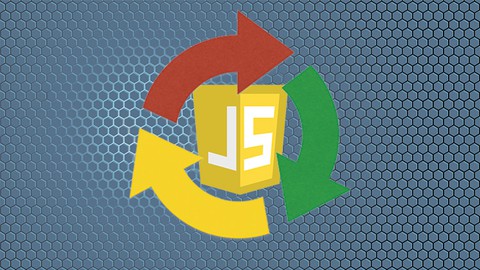
Asynchronous JavaScript Deep Dive
Asynchronous JavaScript Deep Dive, available at $84.99, has an average rating of 4.6, with 67 lectures, 1 quizzes, based on 353 reviews, and has 7347 subscribers.
You will learn about In-depth training on asynchronous JavaScript. Fundamental concepts about asynchronous JavaScript. How asynchronous JavaScript is achieved using the event loop. The ubiquitous callback pattern. Problems we encounter with callbacks. The ins, outs and whys of JavaScript promises. The fetch command. The async await pattern. The new way of handling asynchronous code. Iterators and Generators and when to use them. This course is ideal for individuals who are Anyone who wants to master Asynchronous javascript. It is particularly useful for Anyone who wants to master Asynchronous javascript.
Enroll now: Asynchronous JavaScript Deep Dive
Summary
Title: Asynchronous JavaScript Deep Dive
Price: $84.99
Average Rating: 4.6
Number of Lectures: 67
Number of Quizzes: 1
Number of Published Lectures: 67
Number of Published Quizzes: 1
Number of Curriculum Items: 68
Number of Published Curriculum Objects: 68
Original Price: $74.99
Quality Status: approved
Status: Live
What You Will Learn
- In-depth training on asynchronous JavaScript.
- Fundamental concepts about asynchronous JavaScript.
- How asynchronous JavaScript is achieved using the event loop.
- The ubiquitous callback pattern.
- Problems we encounter with callbacks.
- The ins, outs and whys of JavaScript promises.
- The fetch command.
- The async await pattern. The new way of handling asynchronous code.
- Iterators and Generators and when to use them.
Who Should Attend
- Anyone who wants to master Asynchronous javascript.
Target Audiences
- Anyone who wants to master Asynchronous javascript.
Effectively working with asynchronous code in JavaScript is an essential skill for anyone working with JavaScript. Asynchronous patterns are used extensively. This course will take you from a beginner or intermediate level to mastering asynchronous JavaScript. You will feel comfortable dealing with any asynchronous code.
This course start with the basics of asynchronous coding in JavaScript. We take a look at the event loop and the role it plays in asynchronous JavaScript. We dig into the original asynchronous pattern, the callback. We dive into Promises, and tackle this subject in depth. We then add the async await pattern to the discussion. In the last section we cover generators and how and when they can be used in your code. Code example are used throughout the course and there are plenty of chances for you to try things on your own.
By taking this course you will be able to:
-
Explain the role of the Event Loop in asynchronous coding.
-
Use callbacks throughout your code.
-
Incorporate and work with promises no matter the source.
-
Use the async await pattern to make your asynchronous code easier to reason about.
-
Incorporate generators when needed.
This is one of the best courses produced on asynchronous JavaScript. It contains unmatched coverage. If you are looking to learn this very important topic, this course is for you.
Course Curriculum
Chapter 1: Introduction
Lecture 1: Introduction
Lecture 2: Making the Most of this Course
Lecture 3: Important Notes about Course
Chapter 2: Understanding Asynchronous Coding
Lecture 1: Introduction to Asynchronous Coding
Lecture 2: Synchronous VS Asynchronous
Lecture 3: Advantages and Disadvantages
Lecture 4: Understanding the Event Loop
Lecture 5: The Event Loop Take 2
Chapter 3: The Necessity of Callbacks
Lecture 1: Introduction to Callbacks
Lecture 2: Understanding JavaScript Callbacks
Lecture 3: Understanding JavaScript Callbacks Part 2
Lecture 4: Asynchronous Coding and Callbacks
Lecture 5: Exercise 0 Start
Lecture 6: Exercise 0 Finish
Lecture 7: Problems with JavaScript Callbacks
Chapter 4: Promises
Lecture 1: Promises Introduction
Lecture 2: Understanding Promises
Lecture 3: Using Promises Part 1
Lecture 4: Using Promises Part 2
Lecture 5: A Quick Overview of Fetch
Lecture 6: Promise Example 1: Star Wars Data
Lecture 7: Promise Example 2: JSONPlaceholder
Lecture 8: Promise Example 3: jQuery
Lecture 9: REVIEW: IFFEs and the Module Pattern
Lecture 10: Exercise 1 Start
Lecture 11: Exercise 1 Finish
Lecture 12: Exercise 2 Start
Lecture 13: Exercise 2 Finish
Lecture 14: Creating JavaScript Promises
Lecture 15: Exercise 3 Start
Lecture 16: Exercise 3 Finish
Lecture 17: Follow Up on Exercise 3
Lecture 18: Using the Finally Method
Lecture 19: Using the Promise all and race Static Methods
Lecture 20: Exercise 4 Start
Lecture 21: Exercise 4 Finish
Lecture 22: Two New Static Methods: Promise.allSettled and Promise.any
Lecture 23: Aborting a Promise
Chapter 5: Async Await
Lecture 1: Introduction to Async Await
Lecture 2: Getting Started with Async Await
Lecture 3: REVIEW: The map Method of Arrays
Lecture 4: Using Async Await
Lecture 5: REVIEW: The filter Method of Arrays
Lecture 6: Exercise 5 Start
Lecture 7: Exercise 5 Finish
Lecture 8: Refactoring jQuery Promise Example: try catch / for of
Lecture 9: Follow Up on try catch
Lecture 10: Refactor JSONPlaceholder Promise Example: IIFEs
Lecture 11: Exercise 6 Start
Lecture 12: Exercise 6 Finish
Lecture 13: Exercise 7 Start
Lecture 14: Exercise 7 Finish
Lecture 15: Using Promise.all with async await
Lecture 16: Exercise 8 Start
Lecture 17: Exercise 8 Finish
Lecture 18: Careful Coding with async await
Lecture 19: Using async on Object Methods
Chapter 6: Making Use of Generators
Lecture 1: Introduction to Generators
Lecture 2: Understanding and Using Generators
Lecture 3: Generator Example
Lecture 4: Exercise 9 Start
Lecture 5: Exercise 9 Finish
Lecture 6: Using a Generator to Create an Iterator
Lecture 7: Creating an Iterator Example 2
Lecture 8: Two-way Communication with Generators
Chapter 7: Conclusion
Lecture 1: Congratulations!
Lecture 2: BONUS Lecture! Discounts on Other Courses
Instructors
-
Steven Hancock
Owner All Things JavaScript
Rating Distribution
- 1 stars: 1 votes
- 2 stars: 8 votes
- 3 stars: 21 votes
- 4 stars: 92 votes
- 5 stars: 231 votes
Frequently Asked Questions
How long do I have access to the course materials?
You can view and review the lecture materials indefinitely, like an on-demand channel.
Can I take my courses with me wherever I go?
Definitely! If you have an internet connection, courses on Udemy are available on any device at any time. If you don’t have an internet connection, some instructors also let their students download course lectures. That’s up to the instructor though, so make sure you get on their good side!
You may also like
- Best Video Editing Courses to Learn in March 2025
- Best Music Production Courses to Learn in March 2025
- Best Animation Courses to Learn in March 2025
- Best Digital Illustration Courses to Learn in March 2025
- Best Renewable Energy Courses to Learn in March 2025
- Best Sustainable Living Courses to Learn in March 2025
- Best Ethical AI Courses to Learn in March 2025
- Best Cybersecurity Fundamentals Courses to Learn in March 2025
- Best Smart Home Technology Courses to Learn in March 2025
- Best Holistic Health Courses to Learn in March 2025
- Best Nutrition And Diet Planning Courses to Learn in March 2025
- Best Yoga Instruction Courses to Learn in March 2025
- Best Stress Management Courses to Learn in March 2025
- Best Mindfulness Meditation Courses to Learn in March 2025
- Best Life Coaching Courses to Learn in March 2025
- Best Career Development Courses to Learn in March 2025
- Best Relationship Building Courses to Learn in March 2025
- Best Parenting Skills Courses to Learn in March 2025
- Best Home Improvement Courses to Learn in March 2025
- Best Gardening Courses to Learn in March 2025






















